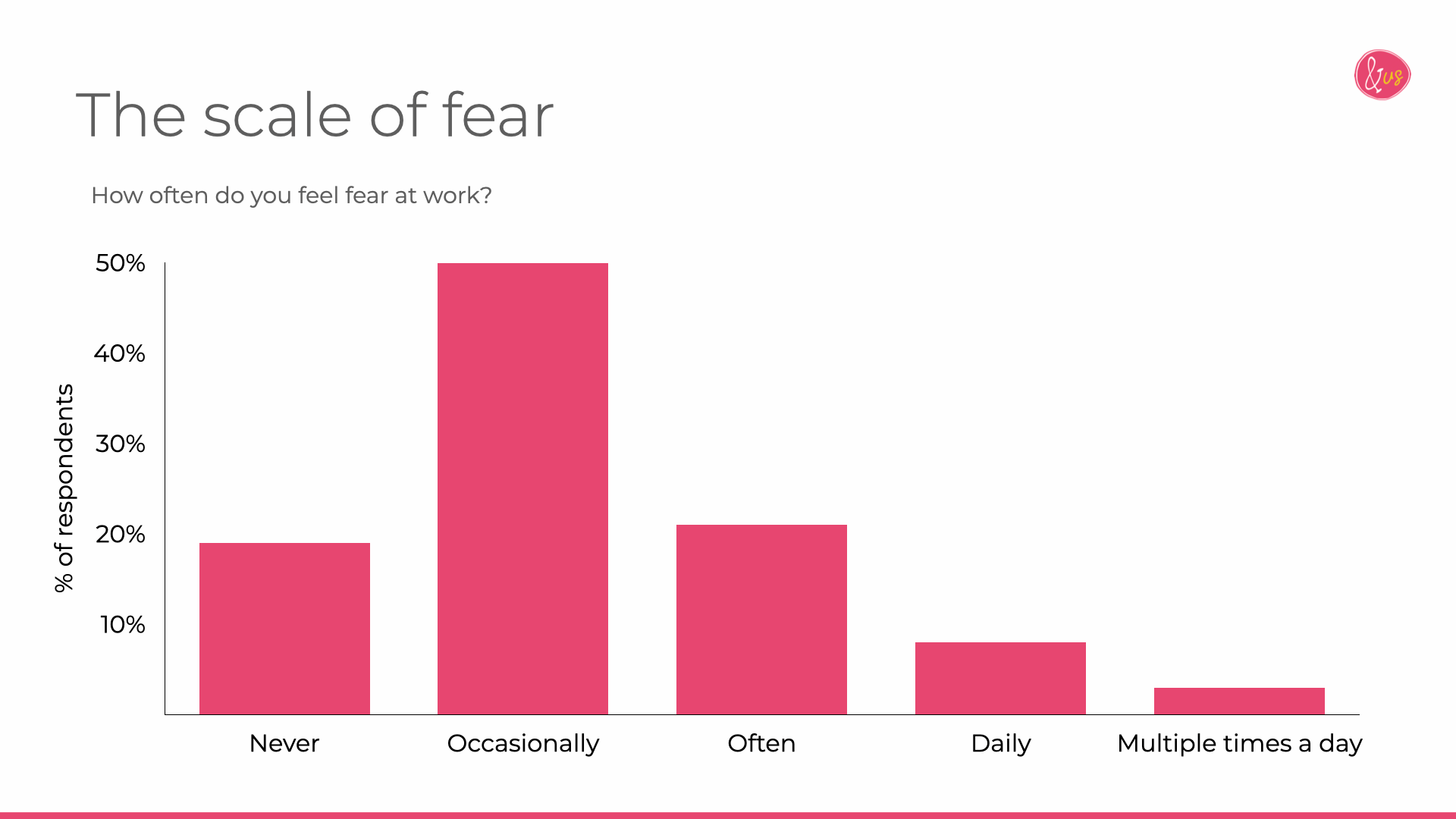Felicity Walsh, strategist at growth consultancy &us shares some exclusive research into fear and innovation at work
When we think about fear, often people talk about the fear of change, as if all change is the same. Elements of change can be daunting, sure, but when change is on our terms and under our control, it can be motivating, exciting and refreshing. What tends to be frightening is the ambiguity that too often surrounds change.
Organisations are often poor at communicating transformation plans; leadership sometimes use vague language in an attempt to buy time or keep conflict at bay. Giving employees half of a story is dangerous, as they begin to fill in the gaps, circulating gossip. They may even behave differently to protect themselves, and their jobs; ‘peacock’, and overcompensate.
“The first 10 minutes of every meeting are taken up with who knows what”.
At &us, we’ve just finished a piece of research (click on the graph on this page to expand it) on fear in the workplace, because we believe that fear - and the impact of fear - is the single biggest thing holding innovation back in companies all across the country. We were astounded by the scale of fear. A third of UK office employees are scared at work. But how does it manifest itself, and how can we beat it. Alongside some hefty quantitative research conducted amongst 3000 UK workers in varying roles and industries, we needed honest conversations oozing with insight.
So, we decided to anonymously interrogate some of the UKs most bright and innovative minds who have experienced and led major workplace transformation. We interviewed heads of innovation at big brand organisations. Sometimes we can look to the “Innovators”, confused as to whether they are our friends or foes. Our interviewees had been accused of being ‘glory hogs’, had felt like spare parts, and sometimes like saviours! But they helped us uncover the two biggest drivers of fear and barriers to change, at work.

1. Innovation can’t happen if it’s not defined
Defining successful innovation is difficult and brave, the outcome often transient. The result? Not enough businesses say what they mean when they say that they want innovation! Seem familiar? We found that the most fearful cultures arise when goalposts keep moving. Ever moving goalposts make it impossible to define success, and by default, failure. Vulnerability and bravery sit at the core of ideating.
To grow the great ideas and destroy the troublesome ones, teams need to be vulnerable, resilient, and have a mutual understanding of their objective. Ideas are personal, so you need objective definitions that allow you to know when and how to kill them. Off the top of your head, could you articulate the definition of innovation in your business? Be honest. Especially in this mad world we’re currently in, where progress has never been more important, it’s essential you give this a go.
Our interviewees provided us with a a good starting point:
“The goal is to have a healthy lifeblood of ideas”
“90% sweat, 10% inspiration. It’s about getting the great ideas done”
“Thinking creatively around a problem is innovation”
“Striving towards having complete mastery”
“Being an innovator is about saying what you think”
2. Innovation works when it’s distributed
In our research, ‘visibility’ was a major driver of fear at work. Within blame cultures, not enough individuals want to put their heads above the parapet and assign their name to change. To combat this, innovation needs to become everyone’s responsibility. Unless you help employees feel the positive impact of change for themselves, it’s human nature to resist. According to our quant survey 45.3% of people who feel fear at work have already been through some kind of business change, in what we’ve dubbed ‘transformational trauma.’ They don’t want the same to happen again! And your innovation shouldn’t just sit within a white middle-class guy’s remit. There is a wealth of research indicating that diversity is a key driver of innovation (Forbes 2011).
One of our interviewees, the Head of Innovation at a global energy company, spoke about their inclusive lab. Individuals are invited from all areas of the business to take secondment and spend time with the innovation team. From call centre workers to data scientists, every employee’s opinion is valued and valid. For a business to successfully innovate and transform, innovative ideas need to feel contagious. We spoke to a transformation lead at a leading UK bank about their innovation initiative. They invite self-made teams across the business to pitch to the board a product or service, a piece of tech, that could improve the company. The successful pitch happens. Whether it be employee onboarding or product features, the process of ideating is celebrated and ceremonious.
The gamification of innovation is proven to work. Our favourite example of this is the ‘speed camera lottery’ Sweden, where drivers who stick within the speed limit are entered into a cash lottery. A reward of status, bonus or even fun at work taps into the psychology of positive reinforcement.
Don’t say no to something because it feels complicated, or send employees off on wild goose chases and red tape to get stuff done. Be clear, encouraging, be open, and you will see your teams become braver than ever.
This article came from issue 9 of Marketing Society publication Empower. Read the archive here.



